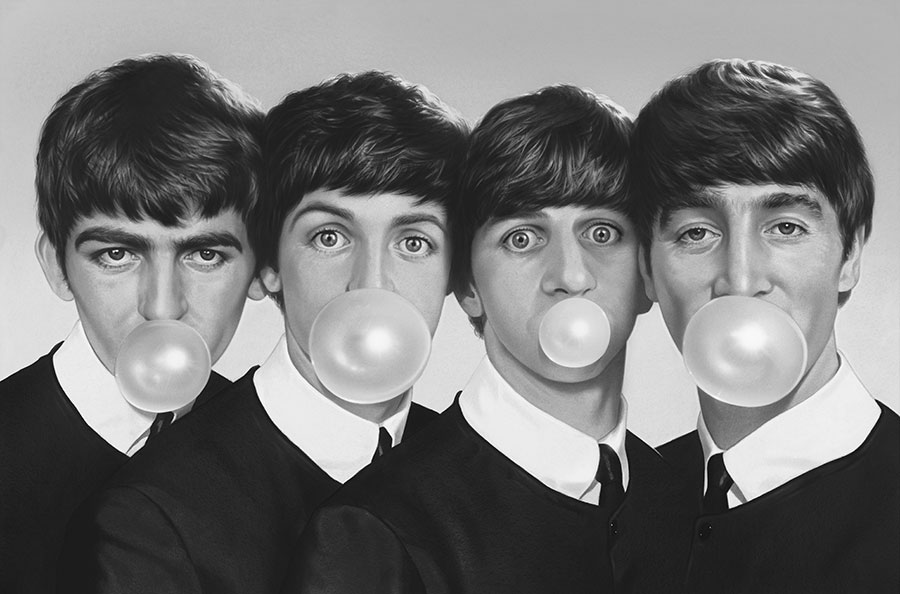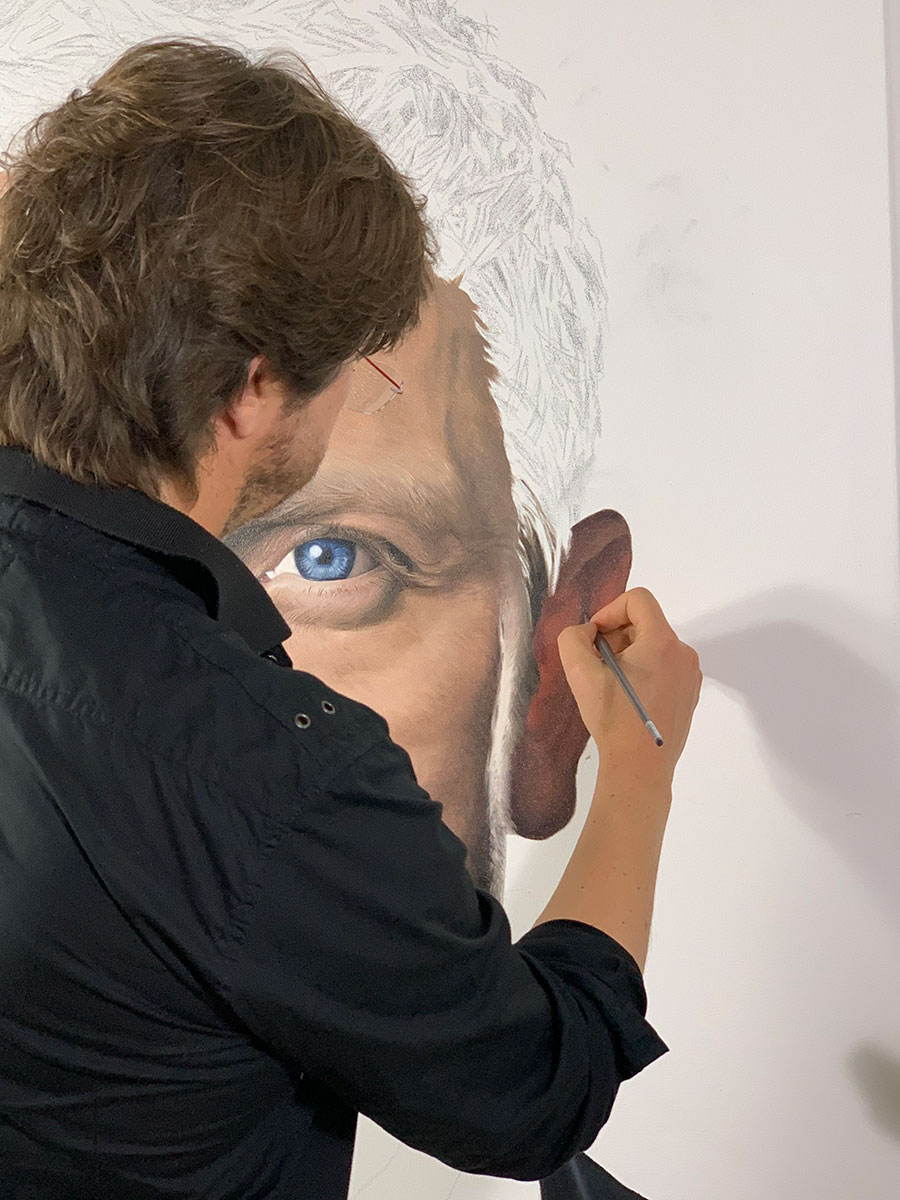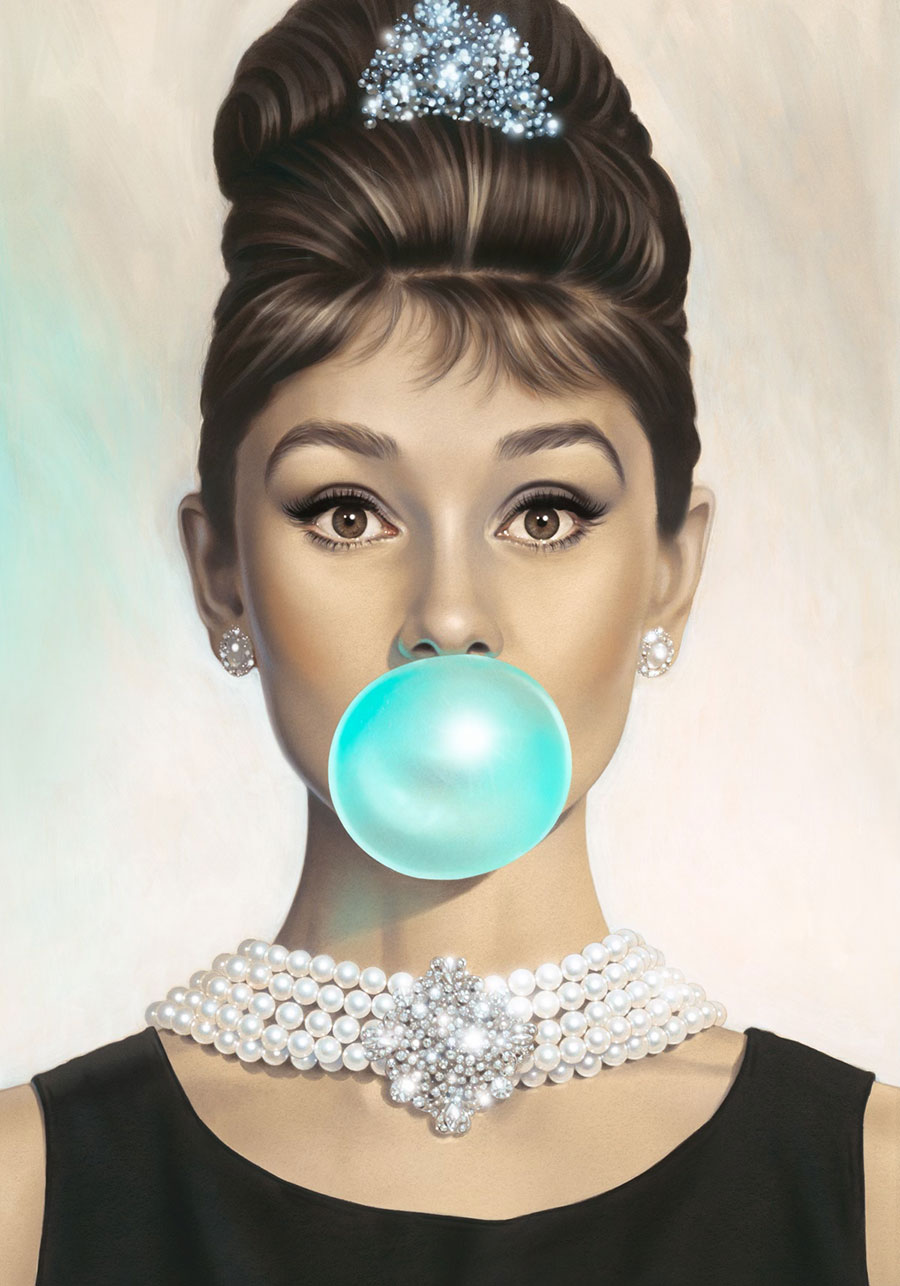Michael Moebius Talks His Famous Bubble Gum Paintings and AI in Art Ahead of New Toronto Exhibit

Queen Bubblegum (2016), by German artist Michael Moebius, is on display in a rare Canadian gallery exhibition of Moebius's work in Toronto. It will also adorn the exterior of a sales presentation centre for an upcoming condo development in the city's downtown core. Photo: Courtesy of Michael Moebius
The distinctive portraits of contemporary German artist Michael Moebius are rooted in hyperrealism, a centuries-old practice to capture intense realism in expressions, features and plays of light in fine detail. His irreverence, however, is firmly planted in the pop art tradition.
Among Moebius’s best-known works is his amusing series that depicts pop culture icons — like David Bowie, the Beatles, Steve Jobs, Kate Moss, Karl Lagerfeld, Audrey Hepburn, Dirty Harry and even Queen Elizabeth II – blowing bubble gum bubbles. In authorized archival giclée prints, they have become prized by collectors like Paris Hilton and the late Hugh Hefner.
They’ve also become recognizable and ubiquitous, unfortunately, through unsanctioned counterfeit versions; after winning a landmark $120 million intellectual property victory in May, Moebius is now pursuing controversial Chinese fast-fashion retailer Shein for copyright violation.

Moebius, 55, grew up in Pirna, a suburb in then-communist East Germany. After two decades of living in Los Angeles, he is back in Dresden (“a very romantic and charming city”). The artist made his first visit to Canada during this year’s Toronto International Film Festival to attend the annual Artists for Peace and Justice (APJ) Festival Gala, where his donation of a triptych of the Queen and Queens Guard (Her Majesty, flanked by Kate Moss and Naomi Campbell) helped the auction portion of the evening raise more than $300,000 for APJ’s educational initiatives in Haiti.
Toronto’s vibe is “a more relaxed New York,” he says, during a trip where he also spent time consulting on interior design that will integrate his art within Q Tower, a 60-story residential tower planned Toronto’s Harbourfront neighborhood. That’s Q as in “Queen” — the theme is monarchy and, pre-construction, a monumental version of Moebius’s “Queen Bubblegum” will adorn the sales presentation centre’s exterior, visible from the Gardiner Expressway. His original oil paintings of Her Majesty and Audrey Hepburn also make a rare visit to Toronto at Galerie de Bellefeuille (Sept. 22 to Oct. 3).
On a sun-drenched morning at Bisha Hotel’s rooftop terrace, Moebius sat down with Zoomer contributor Nathalie Atkinson to talk pop culture, art, and the rise of AI.

NATHALIE ATKINSON: When people aren’t familiar with your art, what’s usually their first reaction to seeing it?
MICHAEL: MOEBIUS: Always giving a smile. Because they know the characters. They’re very familiar with them but the twist is so playful and it makes them really happy. It gives a warm, great, happy feeling.
NA: With your signature gesture of blowing a bubble, those pieces work because of the juxtaposition of silliness and seriousness and a cultural respect for the subjects. It just wouldn’t work if it was someone who was kind of a joke figure.
MM: You have to find the right people. You can give them a twist. You don’t expect it.
NA: So how do you choose new subjects? For example, I notice you’ve been teasing out painting what looks like Daniel Craig’s eyes on your Instagram lately.
MM: The James Bonds are cool. They’re coming out in the spring — all six of them. They’re strong masculine characters, and they give this playfulness with the bubble gum. They each had their little humour — even Daniel Craig had his own humour, he didn’t show it so much with the expressions [in the movies] but in his sarcasm.

NA: Growing up in the Eastern bloc, in those years when many were coveting Levi’s and other western goods, what icons or objects from the West captured your imagination as a young teen?
MM: For me it was actually Marilyn Monroe. I was always Marilyn first, because I was so in love with (and still in love with!) Billy Wilder’s movie, Some Like it Hot.
NA: I thought for sure you were gonna say The Seven Year Itch. Interesting.
MM: It’s also good! But Some Like it Hot is in black-and-white, which has this nostalgic edge to it. As you know, in East Germany, we didn’t have so much access. We couldn’t even have television. And I was always amazed by Disney characters — highly forbidden. Think about it: the idea that Donald Duck or Coca-Cola was a threat to East Berlin makes no sense, but that’s what it was. Everything was based on propaganda. In East Germany, everything was faded and grey. The bubble gum didn’t taste good.
Nothing was colourful, it was like you were living in a black-and-white movie. And when the (Berlin) Wall came down, all the best products came into East Germany and just simple things like a yogurt cup was so colourful being full of strawberries and cherries. It made such a difference.
NA: Our culture, I would argue, is much more fragmented now. Do you think it’s going to be harder in the future to find larger-than-life cultural figures in the way we have now, as subjects for your work, who not only transcend borders but generations?
MM: The people will be different. That’s what I’m questioning myself, to get such iconic characters. They may be lost for so many new generations. You can ask 10-year-old kids today and they know Audrey Hepburn and Marilyn Monroe, for example. That will be very rare in the future.

NA: That’s actually an interesting question because it’s your art of Queen Elizabeth — and James Bond—that will be going in at Q Tower. When is the new King Charles going to be interesting enough for you to do him as a bubble gum?
MM: [Laughs] I’m thinking about it.
NA: I haven’t seen the original oil paintings myself, can you talk a little bit about the inspiration for your technique?
MM: It has a lot of influences, actually. A lot of different artists. You have to find your style and in the beginning I didn’t really have my own, I was mostly copying people, like copying what [famed Italian artist and movie poster illustrator Renato] Casaro did. It’s very important that you find your own signature. I think [with] the bubble gums, you cannot really plan for such a success. It’s impossible. My stomach tells me what’s right and what’s wrong. It’s for my own satisfaction. I’m happy that something lit and got so viral — I was amazed, actually, by it.
NA: But while you’re pulling from pop art traditions and cultural icons, I’ll see you’ll mention something like Christian Seybold’s painting “An Old Woman” [1947] on your Instagram for technique and style. Is that the piece of art you go back to for inspiration often? Or is there another artist whose work you visit?
MM: [18th Century Italian painter] Canaletto is, to me, the best. We have Dresden’s Old Masters Picture Gallery. It’s a phenomenal collection, with a huge collection of Canaletto paintings. He did a lot of beautiful pieces of Venice, Dresden and Pirna. They assumed, because he did so many paintings of Pirna, he must have had a girlfriend or muse there. That’s the story. It’s so striking because you feel like you’re in the paintings, they’re so photorealistic.

NA: We’re in this moment where artists and writers are talking about generative artificial intelligence (AI). What are the conversations you’re having right now with creative friends around what AI is going to do to art and creativity?
MM: I always love evolution. AI is very important and fascinating and kind of also scary how fast it is. You know? It will change a lot of things. Just yesterday I saw photo shoots of fashion in AI …
NA: … and Coca-Cola is already using it in advertising.
MM: They don’t even need to hire photographers anymore! I’m concerned about it replacing people, and also the copyright issues. Who owns the copyright? Obviously there’s a ruling right now that AI generation is not copyrightable [without adequate human input].
NA: And the idea of whether it’s considered creative without human input. Someone could input every piece of art you have ever made and then output versions. But the difference is the human element where there’s no human creativity.
MM: I’m also kind of curious about AI and the fact that we’re getting visually overstimulated, and tired, because this is moving so fast. Everything is. How can you impress, in the future, your audience with a new idea? But things made by humans will always be special and will always make a difference. AI cannot look at my brain — AI eventually cannot compete with it for ideas.
I don’t really want to do only bubble gum. I’m always looking for new challenges. I’m coming out with a new image, unveiling it at Art Basel Miami, of Marilyn Monroe, Elvis Presley and James Dean holding the Academy Award. I painted it in a way that they’re celebrating like crazy with beautiful, honest satisfaction in their faces holding the Oscars — which they never got close to but deserved more than anyone else because they really have, for decades, represented Hollywood. Like a lifetime achievement award. It’s a playful image.
NA: Do you still have the original Audrey and Marilyn bubble gum?
MM: Yes. We’re not interested in selling them — for now. Because we want to put them on view worldwide, travel to galleries and museums. They’ve been copied by everyone. So many people instantly recognize them. Going back to AI — the speed at which content is produced and put out there, more often than not the actual creators are left behind, while their creations are known by everyone.
RELATED: